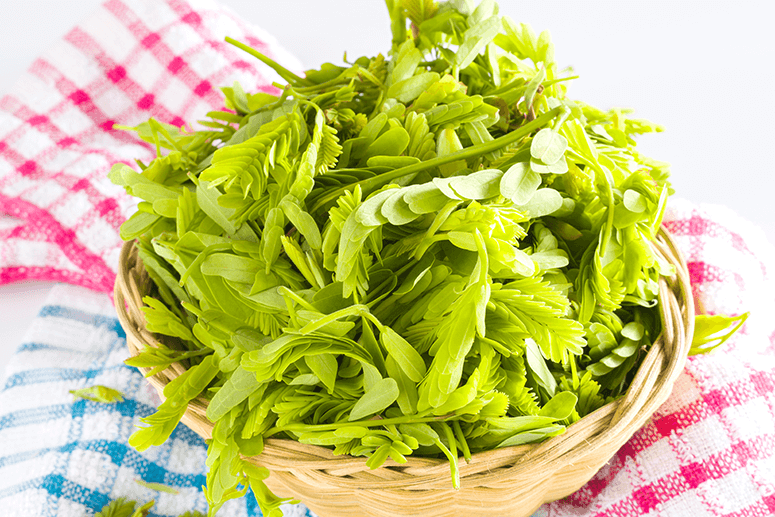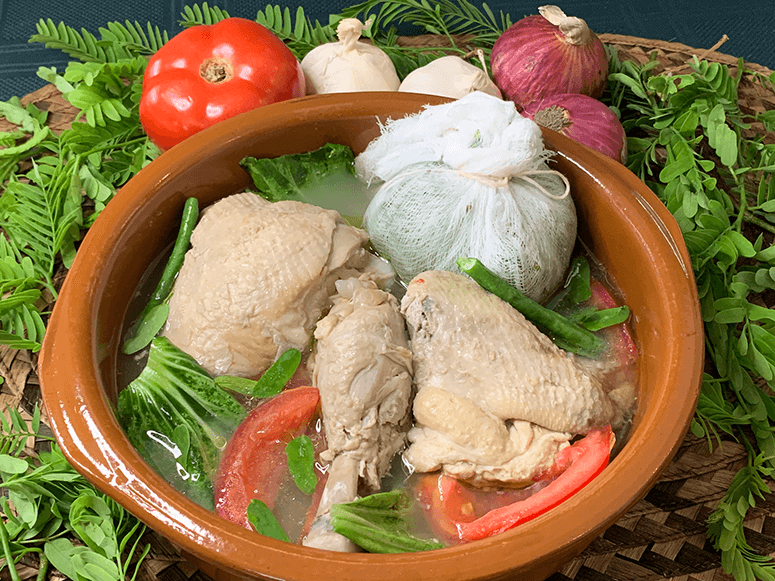Sinigang with a fresh whisper
Thanks to my friend Christine Chanbonpin Go, I can finally cook sinampalukang manok.
For years, I’ve been dreaming of this chicken dish simmered in the young leaves of the tamarind tree. The first time I had it, I was with some editors of the old Chronicle newspaper, where I worked many years ago. We were in a rustic restaurant near Ortigas Avenue, when that area was still mostly wilderness (you can imagine how long ago that was). Unlike sinigang which is aggressively sour, the sinampalukang manok we had that day had a sourness that was suggestive; rather than being well-pronounced, more like a soft whisper than a loud shout. It was like eating mango that was manibalang, somewhat ripe yet still raw enough to be just on the brink of sourness. Perhaps that was what made it so appealing, so memorable.
Maybe because it requires fresh, young tamarind leaves, which are not easy to find in the city, not many restaurants in Manila serve this dish. Heaven forbid that they would use a packaged sinigang mix! While I do use the mix for making sinigang, it’s too sour for sinampalukang manok, which calls for a flavor that’s subtle, not mouth-puckering. Think of it as more of a gentle breeze, rather than a howling wind.

My longing to cook my own sinampalukang manok finally came to fruition last week, in the house of Christine. For there, in her beautiful garden, grows a sturdy, towering tamarind tree. The generous person that she is, Christine asked the driver to hook down some leaves for me with the use of a trusty sungkit. What a joy! We bundled the leaves carefully and I went home with what I felt was a treasure trove of the freshest, finest tamarind leaves for my sinampalukan.
Back home, I dug out an old cookbook that I knew had the step-by-step illustrations for cooking sinampalukang manok. True enough, the recipe called only for sampalok leaves, not sinigang mix. Last Sunday, after making sure I had all the proper ingredients, I finally cooked my first sinampalukang manok.
It was so gratifying. The fresh leaves were fragrant with the aroma of tamarind and hinted ever so gently of sourness. Indeed, the leaves of the sampalok tree are intrinsically sour, which is why one doesn’t need a sinigang mix for this dish. As long as you use enough leaves and simmer the chicken properly, the soup will be sour enough.
Nevertheless, it does help to add the juice of fresh, raw sampalok, too, which was what I did. I simmered about one-half cup of raw sampalok fruits in about one cup of water for 10 to 15 minutes, pressing the fruits now and then to draw the juices out. Then I strained the liquid through a sieve, pressing the fruits some more to draw out more juices. I then incorporated this liquid into the simmering chicken, along with a bouquet garni of sampalok leaves.
The dish turned out to be all I had hoped it would be: fragrant, piquant, totally comforting and so satisfying.
For those who want to have a taste of this soulful dish, here’s the recipe.
Sinampalukang Manok

Ingredients:
- 1 whole chicken, sliced into serving pieces or six to eight pieces favorite chicken parts (drumsticks, wings, thighs, etc.)
- 4-5 calamansi
- 5 cups sampalok leaves, plus additional for simmering
- ½ cup raw sampalok fruit
- 1 cup water for the raw sampalok
- 1-2 tbsps cooking oil
- 2-3 slices ginger
- 1 medium onion, sliced
- 3 garlic cloves, chopped
- 3 medium size tomatoes, sliced vertically
- 8-10 cups water
- 1 small bunch green beans (sitaw), cut into serving pieces
- 6-8 pcs okra, washed and well cleaned
- 4-6 kangkong or mustard (mustasa) leaves
- 2 tbsps patis
Procedure:
- Wash the chicken well, then squeeze calamansi juice over it. Let stand for a few minutes. Meanwhile, wash and trim the sampalok leaves (remove the stems). Wrap the leaves in cheesecloth and tie the cheesecloth well to secure the leaves (this is the bouquet garni).
- In a small pan, simmer the fresh raw sampalok in one cup of water for 10 to 15 minutes, pressing the sampalok with the back of a spoon to draw out the juices. When the liquid has turned greenish, remove from heat. Strain the liquid through a sieve, again pressing the sampalok to draw out more juices. Set the liquid aside.
- Heat the cooking oil in a large non-reactive pan (not aluminum) and sauté the ginger on medium-low heat for one to two minutes. Add the onion and sauté till tender. Stir in the garlic and tomatoes. Continue sautéing until the tomatoes are softened.
- Add the chicken and sauté until lightly browned. Pour in the water. Turn up the heat to bring to a boil, then lower heat to a simmer (cover the pan to make it boil faster). Simmer for 15 minutes. Add the bouquet garni of tamarind leaves then pour in the liquid from the raw tamarind fruits and simmer for another 10 minutes.
- Stir in the green beans and okra and season with patis. Simmer for another 10 minutes or until the chicken is tender and vegetables are just cooked through. Lastly, add the kangkong or mustard leaves and sprinkle in some additional sampalok leaves. Simmer again for two to three minutes to soften the kangkong or mustard leaves. Spoon out the bouquet garni and squeeze it over the soup to release more sourness into the soup. Taste the soup and add more patis if needed. Serve hot with rice and with a patis dip on the side, if desired. Makes four to six servings.


